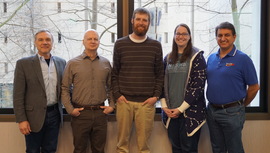The Dust Mights team will be searching for Galactic sources in the Spitzer Enhanced Imaging Products catalog which have an excess amount of infrared light and whose distances are known from Gaia observations.
The Spitzer Enhanced Imaging Products catalog (SEIP) contains millions of sources that have been serendipitously imaged as part of other projects. The SEIP contains the largest sample of sources detected at 24 microns fainter than 8th magnitude, many of which may exhibit an infrared excess at that wavelength. Finding an excess of infrared radiation in a source’s spectral energy distribution can indicate the presence of dust, which is often an indicator of an interesting evolutionary phase. The dust grains absorb shorter wavelengths of light, heat up, and reradiate that energy in the infrared. This study will build upon the work of three previous studies of infrared excess sources found in the SEIP while attempting to find fainter objects than those surveys had been able to identify. After using the SEIP to find infrared excesses, the sources will then be manually confirmed, discarding any with a signal-to-noise ratio of less than 5. Then, the sources will be inspected visually using the IPAC/NASA Infrared Science Archive (IRSA) Viewer to ensure that the fluxes of the identified sources are free from contamination by nearby objects. Using the distances from the Gaia archive will allow us to concentrate on Galactic sources, narrowing the focus of this study. This new catalog of infrared excess sources will provide a rich opportunity for further study by current and future infrared telescopes.
Caltech, Pasadena, California
Academy of Information Technology & Engineering, Stamford, Connecticut
Thomas Jefferson High School, Council Bluffs, Iowa
Madison Metropolitan School District Planetarium, Madison, Wisconsin
Mr. Holt got some nice local press and coverage in his school district.
Many NITARP alumni helped us out with reviewing the NITARP 2019 proposals! Scientists who helped include Tiffany Meshkat, Marja Seidel, Sergio Fajardo-Acosta, Mike Werner, and Julian van Eyken. Thanks to all!
